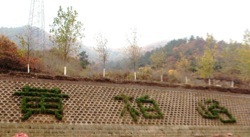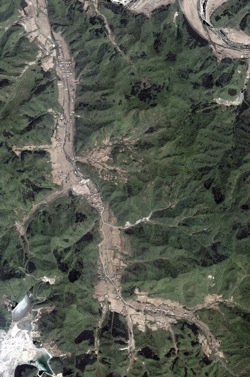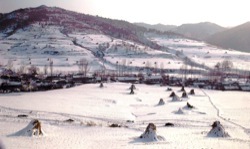
Huangbaiyu The Place
perspectives on a site
Huangbaiyu, like any thing, means different things to different people. Huangbaiyu is at the same time a trademark, a series of ravines in eastern Liaoning, a sustainable development project, a type of stone, a valley filled with yellow cypresses, the hope for a green urban future, a linguistic marker for a level of government administration, a lure to attract American investment, and a home. Those ways of understanding Huangbaiyu only account for meanings in the present. Huangbaiyu also has a past, remembered by those persons whose lives have been lived or intersected there, and certainly will have a future.
Exploring each of these present meanings, their relationship to the remembered past and a dreamed about future, and whose perspective each of these renderings belong to, is critical to understanding the complexity of what Huangbaiyu can teach us about . That is the goal of my doctoral dissertation, which I will share when complete.
For now, let a brief introduction to the geography--both physical and social--of the the series of villages that comprise the valleys of Huangbaiyu suffice.

the valleys and villages
Heading south from Benxi city on National Road 304, the structures of the city disintegrate--the road is ravaged by potholes
As National Road 304 stretches beyond the plains of Shenyang it begins to climb the rolling hills at the western edge of the Changbai mountain range, and enter Benxi. Continuing south, the road winds up the ever steeper foothills that rise from here eastward into Jinan, and North Korea. At Thousand Pieces of Gold Gully the road peaks, and an avalanche of plastics, metals, furniture, and rotting food replaces the mixed pine forest that once covered the mountainside. The city and its waste recede. The countryside lies ahead.
The serpentine road twists down toward a narrow valley, and the houses that comprise the small hamlet of Stone Lake begin to appear to the west. The road climbs onward, laboring back up the foothills that have long since grown into mountains. Around another bend, a three streams tumbling down from further ravines form a river that has carved a plain from the mountainside. The hamlet of Three Rivers occupies this land, with orchards of plum and pear planted on the communal lands still bearing fruit decades later.
The road continues southward. The land begins to narrow. The first hamlet in the valleys collectively called Huangbaiyu strains from the road west, and up. Up the rocks and into the mountain a handful of homes cling to a land literally named: Deep Gully. A little further on, the road takes a sharp turn, bridging the main river of Huangbaiyu. A stand of poplars grows along the river’s edge to the north, rectangular pools of trout reach south.
Here is Zhao Family Riverside, the largest of Huangbaiyu’s villages. Some 80 households spread both east and west of the road, and even up into the entrance of the far west gully where the rare green and purple striated rock that has been prized for carving inkstones since the Liao and Jin period a thousand years ago is scattered across the ground like leaves after a heavy wind. At the northern most end of the village just before the road turns sharply, a couple whose wealth was gained by managing the steel company that made Benxi famous during the years when Mao promised that the ores of Liaoning would build the machines that would finally catapult China beyond the West and into modernity have built a three-story summer retirement home complete with grape trellises and a lap-size swimming pool. Huangbaiyu is their idyll: a landscape of early summer blossoms, dog days in the pool, and the stunning oranges, yellows, and ochres of oak and maple leaves. They leave long before the winter sets in at the end of October. Read more...






Copyright © 2008-2009 Shannon May About me Design Blog Kenya & Life Sundries Blog Contact smay at post dot harvard dot edu
Everything is a work in progress